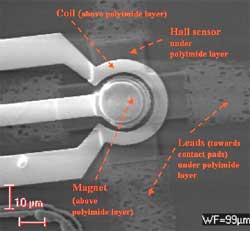Nov 5 2007
Micromem Technologies Inc. is pleased to announce a material progress update on our commercialization of our MRAM. Micromem and Global Communication Semiconductors, Inc. (GCS) have successfully patterned and processed our own magnetic yoke design. This is significant in that this production- level process produced an extremely clean magnetic storage element (below, less than 1/10th the width of a human hair) while at the same time starting a march down a path of memory size reductions and lower cost-per-bit. The scanning electron microscope image illustrates the superior quality of the GCS foundry and its team of engineers.
The process of establishing the function and scalability of the multi-bit MRAM has followed a sequence of first productizing the magnetic storage element (the “yoke”), followed by Hall Cross Sensor characterization, and finally integrated MRAM bit cell performance. With this very successful demonstration of the magnetic structure, Strategic Solutions has characterized the relative efficacy of two alternative methods: electroplating versus sputter deposition, as they relate to the ultimate manufacturing of MRAM product in a dense multi-bit array.

Similar data and a milestone for Hall Cross Sensors should be seen in November. A demonstration of a fully integrated MRAM storage cell is expected by year end. Micromem is in discussion with a major military-focused company that provides GaAs spacebased platforms. Discussions are centered around the proposed MRAM architecture and how it will benefit their current product line in a dense memory array format. “Now that we have structures coming out of the foundry that are showing scalability and that confirm the University of Toronto prototype (image below) and ongoing simulation modeling, it is invaluable to have the input from users” says Steven Van Fleet, Program Director for the Foundry phase of the commercialization process. “Our goal is to incorporate their insight as we move forward not only in deciding upon the initial memory array size they require but also by what process they will want the memory manufactured. Our plan is to engage such companies in a cross licensing procedure. Now that structures are being validated in the foundry we can pursue these discussions in earnest.”
Jon Scadden of Strategic Solutions stated, “We are encouraged and excited about the ultimate simplicity of the Micromem MRAM design; it predicts robust product performance and extremely good reliability and radiation-hardness. It enables an excellent match up to the knowledge base and skill sets of our foundry partner, GCS. Strategic Solutions is the company that Micromem contracted to design and implement the MRAM technology. Strategic is a Grass Valley California based engineering company that specializes in developing new technology, Wafer services, technology evaluations, special engineering projects and short run wafer standard business.